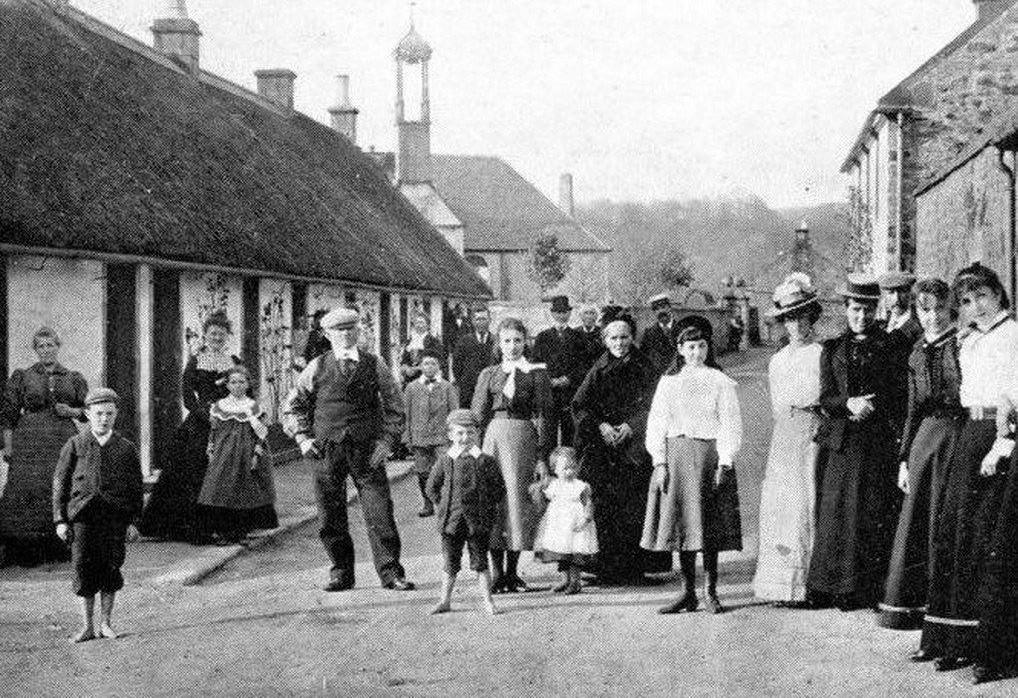
Scottish Regions: The Lowlands

Figure 1.-- The photograph was taken in Dalserf (dal meaning field and Serf a 6th century saint), a small but historic village on the River Clyde in South Lanarkshire in the Scottish Lowlands near Glasgow. Clearly the people dressed up for the photo, even so two boys are barefoot. Note there are no kilts. The photograph is not dated, but clearly was taken before World War I, probably around the turn-of the 20th century. The starly beautiful village kirk dedicated to St. Serf was built in 1655 and dedicated to Saint Serf. It is believed to have been built on the site of a much earlier medieval church. (The steeple is visible in the background.) The 1655 church dates from The Killing Time, when the rebel Covenanters were brutally persecuted for their faith. Dalserf was a center of Covenanter activity.
|
|
The Lowlands is the southern-most area of Scotland birdering on northern England. The Lowlands became heavily Anglicized and often cooperated with the English in the pacification of the Highlands. This regional split was reflected in the culture of the two areas. English became widely spoken in the Lowlands before the Highlands and Islanders adopted English fashions while Highlanders continued to wear traditional garments like the kilt. Historically the Lowlanders were often English allies in the supression of the Higlands. In modern politics the Highland/Lowland divergence seems to be disappearing. both Lowlands and Highlands seem to be moving in the same direction (independence referendum, shift from Labour to the Scottish National Party, and the EU Referendum). In modern times there has been a rivalry between Glasgow and Edinburgh. Edinburgh and Glasgow have recently been trying to patch over their traditional rivalries so that they can co-operate in marketing both cities -- and Scotland in general. But quite what Edinburgh will make of a new masterplan by Glasgow City Council to improve the city's image and presence in Europe by promoting Glasgow as "Scotland's international capital" is anyone's guess. A City Council spokesman pointed out that Glasgow is Scotland's largest city (factually correct) and is its largest provider of jobs and production. It also provides service, retail, educational, cultural, leisure and entertainment facilities on a national scale. He went on to say that it is no idle boast to claim Glasgow is Scotland's international capital. Hopefully, Edinburgh will haughtily disdain such upstart comments, safe in the knowledge that it has been Scotland's capital city and seat of government for centuries.
HBC

Navigate the Boys' Historical Clothing Website:
[Return to the Main Scottish regional page]
[Return to the Main Scottish page]
[Introduction]
[Activities]
[Biographies]
[Chronology]
[Clothing styles]
[Countries]
[Bibliographies]
[Contributions]
[FAQs]
[Glossaries]
[Images]
[Links]
[Registration]
[Tools]
[Boys' Clothing Home]
Navigate the Boys' Historical Clothing kilt pages:
[Main kilt page]
[Kilt suits]
[Scottish kilts]
[Scottish boys clothing]
[Scottish school uniform]
[Highland dance]
[Pipeband]
[Irish kilts]
[Irish boys clothing]
[Irish step dancing]
[Greek kilts]
Created: 7:53 PM 6/30/2016
Last updated: 7:53 PM 6/30/2016



